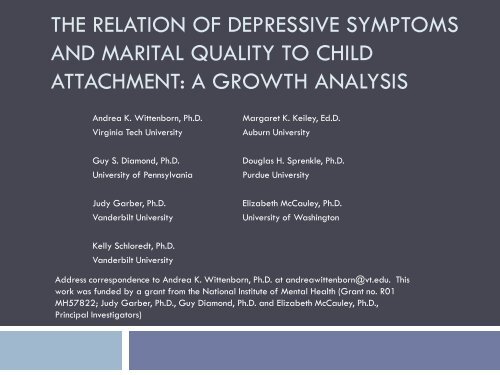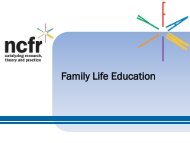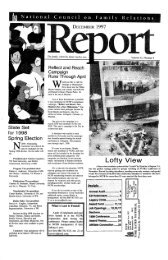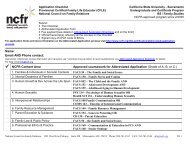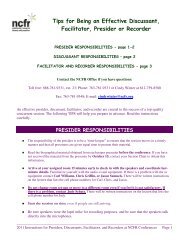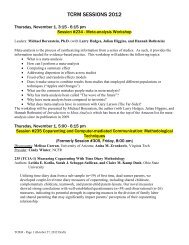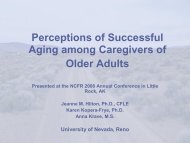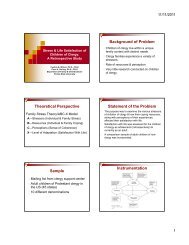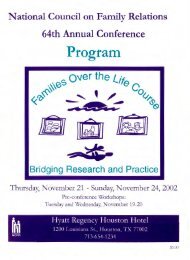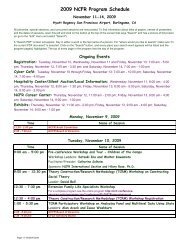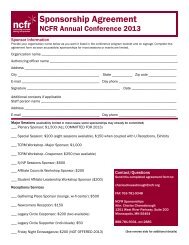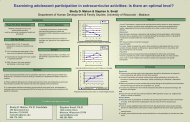the relation of depressive symptoms and marital quality to child ...
the relation of depressive symptoms and marital quality to child ...
the relation of depressive symptoms and marital quality to child ...
Create successful ePaper yourself
Turn your PDF publications into a flip-book with our unique Google optimized e-Paper software.
THE RELATION OF DEPRESSIVE SYMPTOMS<br />
AND MARITAL QUALITY TO CHILD<br />
ATTACHMENT: A GROWTH ANALYSIS<br />
Andrea K. Wittenborn, Ph.D.<br />
Virginia Tech University<br />
Margaret K. Keiley, Ed.D.<br />
Auburn University<br />
Guy S. Diamond, Ph.D.<br />
University <strong>of</strong> Pennsylvania<br />
Douglas H. Sprenkle, Ph.D.<br />
Purdue University<br />
Judy Garber, Ph.D.<br />
V<strong>and</strong>erbilt University<br />
Elizabeth McCauley, Ph.D.<br />
University <strong>of</strong> Washing<strong>to</strong>n<br />
Kelly Schloredt, Ph.D.<br />
V<strong>and</strong>erbilt University<br />
Address correspondence <strong>to</strong> Andrea K. Wittenborn, Ph.D. at <strong>and</strong>reawittenborn@vt.edu. This<br />
work was funded by a grant from <strong>the</strong> National Institute <strong>of</strong> Mental Health (Grant no. R01<br />
MH57822; Judy Garber, Ph.D., Guy Diamond, Ph.D. <strong>and</strong> Elizabeth McCauley, Ph.D.,<br />
Principal Investiga<strong>to</strong>rs)
Abstract<br />
We conducted a multiple-domain growth analysis<br />
examining <strong>the</strong> <strong>relation</strong> <strong>of</strong> <strong>depressive</strong> <strong>symp<strong>to</strong>ms</strong> <strong>and</strong> <strong>marital</strong><br />
<strong>quality</strong> <strong>of</strong> depressed <strong>and</strong> nondepressed mo<strong>the</strong>rs <strong>to</strong><br />
<strong>of</strong>fspring’s perceived attachment. Results from <strong>the</strong> final<br />
fitted model indicated that across 22 months <strong>of</strong> follow-up,<br />
levels <strong>of</strong> <strong>marital</strong> <strong>quality</strong> <strong>and</strong> mo<strong>the</strong>r-<strong>child</strong> attachment for<br />
families with women in treatment for depression were<br />
significantly different from families with mo<strong>the</strong>rs not<br />
suffering from depression. Future studies are needed <strong>to</strong><br />
examine if <strong>marital</strong> <strong>and</strong> family focused interventions in<br />
addition <strong>to</strong> those aimed specifically at reducing depression<br />
more directly affect <strong>the</strong> <strong>quality</strong> <strong>of</strong> <strong>the</strong>ir <strong>marital</strong> <strong>relation</strong>ships<br />
<strong>and</strong> mo<strong>the</strong>r-<strong>child</strong> attachment.
Literature Review<br />
Depression is one <strong>of</strong> <strong>the</strong> most common psychiatric<br />
disorders in adulthood<br />
Depressive <strong>symp<strong>to</strong>ms</strong> interfere with parenting<br />
Links between maternal depression <strong>and</strong> adverse <strong>child</strong><br />
development<br />
Increased risk <strong>of</strong> psychiatric disorders<br />
Increased problems with peers, school, <strong>and</strong> familial<br />
<strong>relation</strong>ships<br />
Increased self-criticism, low self-worth, <strong>and</strong> negative<br />
cognitions
Literature Review<br />
Depressed mo<strong>the</strong>rs experience difficulties related <strong>to</strong><br />
parenting<br />
Increased sad <strong>and</strong> irritable affect<br />
Engage in more intrusive <strong>and</strong> hostile interactions<br />
Exhibit inconsistent parenting practices<br />
Relation <strong>to</strong> parent-<strong>child</strong> <strong>relation</strong>ships <strong>and</strong> <strong>child</strong>ren’s<br />
attachment security<br />
Marital conflict is <strong>of</strong>ten present in families where<br />
parental psychopathology exists<br />
Marital conflict repeatedly has been associated with<br />
poor <strong>child</strong> attachment
Current Study<br />
Examine how <strong>marital</strong> <strong>quality</strong> <strong>and</strong> maternal depression<br />
are related <strong>to</strong> <strong>child</strong>’s perceived attachment <strong>to</strong> mo<strong>the</strong>r,<br />
controlling for group membership, <strong>marital</strong> status, <strong>and</strong><br />
<strong>child</strong>’s age<br />
Extends prior research by using:<br />
Longitudinal data<br />
Quasi-experimental design<br />
Sophisticated growth modeling techniques<br />
Examination <strong>of</strong> all constructs simultaneously
Procedures<br />
Measures<br />
Dyadic Adjustment Scale (DAS; Spanier, 1976)<br />
Inven<strong>to</strong>ry <strong>of</strong> Parent <strong>and</strong> Peer Attachment (IPPA; Armsden &<br />
Greenberg, 1987)<br />
Beck Depression Inven<strong>to</strong>ry (BDI; Beck, Ward, Mendelson,<br />
Mock, & Erbaugh, 1961)<br />
Analysis<br />
Multiple-domain growth modeling
Procedures<br />
Parents received four months <strong>of</strong> treatment (cognitive<br />
behavioral <strong>the</strong>rapy <strong>and</strong>/or pharmaco<strong>the</strong>rapy) for<br />
depression<br />
Mo<strong>the</strong>rs were used because <strong>of</strong> limited number <strong>of</strong> fa<strong>the</strong>rs<br />
Multi-site study<br />
University <strong>of</strong> Pennsylvania<br />
V<strong>and</strong>erbilt University<br />
University <strong>of</strong> Washing<strong>to</strong>n
Procedures<br />
Inclusion/Exclusion Criteria<br />
Clinical group:<br />
• Current Major Depressive Disorder (MDD)<br />
• Scored ≥ 14 on <strong>the</strong> Hamil<strong>to</strong>n Rating Scale for Depression (HRSD17;<br />
Hamil<strong>to</strong>n, 1967).<br />
Nonclinical comparison group:<br />
• No lifetime his<strong>to</strong>ry <strong>of</strong> mood disorders, antidepressant use, psychotic<br />
disorders, personality disorders, suicide attempt, adjustment disorders,<br />
phobias, substance abuse/dependence, psycho<strong>the</strong>rapy longer than<br />
two months or eight sessions, or psychotropic medication use during <strong>the</strong><br />
<strong>child</strong>’s lifetime
Research Timeline<br />
Months<br />
0 2 4 10 16 22<br />
Baseline End Tx Follow-ups
Demographic Characteristics at Baseline.<br />
Treatment Group Comparison Group<br />
Parents<br />
N (%)<br />
Children<br />
N (%)<br />
Parents<br />
N (%)<br />
Children<br />
N (%)<br />
Gender<br />
Female 94 (100%) 55 (58.5%) 77 (100%) 43 (55.8%)<br />
Male 0 (0%) 39 (41.5%) 0 (0%) 34 (44.2%)<br />
Race<br />
Caucasian 68 (72.3%) 62 (66%) 55 (71.4%) 54 (70.1%)<br />
African American 22 (23.4) 22 (23.4%) 19 (24.7%) 18 (23.4%)<br />
Asian 3 (3.2%) 1 (1.1%) 0 (0%) 0 (0%)<br />
Biracial 0 (0%) 9 (9.6%) 0 (0%) 5 (6.5%)<br />
Marital Status<br />
Married 43 (45.7%)* 55 (71.4%)*<br />
Single 19 (20.2%) 14 (18.2%)<br />
Divorced 21 (22.3%)** 5 (6.5%)**<br />
Separated 4 (4.3%) 1 (1.3%)<br />
Widowed 7 (7.4%) 2 (2.6%)<br />
Income<br />
$0-19,999 24 (25.5%)** 5 (6.5%)**<br />
$20-39,999 30 (31.9%)** 14 (18.2%)**<br />
$40-59,999 11 (11.7%) 9 (11.7%)<br />
$60-79,999 15 (15.9%) 12 (15.6%)<br />
$80-99,999 6 (6.4%)** 18 (23.4%)**<br />
$100,000+ 5 (5.3%)* 13 (16.9%)*<br />
Age<br />
Mean 40.27 11.66 42.46 12.08<br />
Range 25-56 7.01-16.09 24-56 7.02-16.10<br />
SD 7.04 2.44 6.58 2.13<br />
SES<br />
Mean 42.47** 47.65**<br />
Range 17-66 14-66<br />
SD 12.62 11.99<br />
Note. T-tests <strong>and</strong> chi-square tests were conducted <strong>to</strong> examine differences between <strong>the</strong> treatment <strong>and</strong> comparison groups.<br />
* p
Estimated growth parameters for <strong>the</strong> final fitted multiple-domain model (N = 171).<br />
Growth Parameter <strong>and</strong> Effect <strong>of</strong><br />
<strong>the</strong> Predic<strong>to</strong>r on <strong>the</strong> Parameter<br />
Mean Level <strong>of</strong> True Initial Status:<br />
Intercept<br />
Effects <strong>of</strong> Group Membership<br />
(mean=.55)<br />
Effects <strong>of</strong> Marital Status<br />
(mean=.57)<br />
Effects <strong>of</strong> Child Age<br />
(mean=11.79)<br />
Estimated Average Rate <strong>of</strong> True<br />
Change: Slope<br />
Effects <strong>of</strong> Group Membership<br />
(mean=.55)<br />
Effects <strong>of</strong> Marital Status<br />
(mean=.57)<br />
Effects <strong>of</strong> Child Age<br />
(mean=11.79)<br />
Estimated Average Acceleration <strong>of</strong><br />
True Change: Quadratic<br />
Logged Maternal<br />
Depression (SE)<br />
Marital Quality<br />
(SE)<br />
Child<br />
Attachment (SE)<br />
.29 (.30) 98.42* (10.50) 139.55* (6.36)<br />
2.36* (.13) -22.96* (4.02) -7.93* (2.42)<br />
-.02 (.13) 7.16~ (4.35) 2.19 (2.43)<br />
.04~ (.02) .61 (.80) -2.74* (.50)<br />
-.97* (.15) -5.91 (8.61) -.36 (.90)<br />
- 7.53 (5.55) -<br />
- 9.63 (6.40) -<br />
- .08 (.46) -<br />
.33* (.07) -2.31~ (1.26) -<br />
Note. Fit statistics <strong>of</strong> final fitted model: χ 2 =130.67 (df=66, p
IPPA<br />
120<br />
100<br />
80<br />
60<br />
Treatment<br />
Comparison<br />
40<br />
20<br />
0<br />
0 4 16<br />
Figure 2. Fitted attachment trajec<strong>to</strong>ry for a pro<strong>to</strong>typical <strong>child</strong> in <strong>the</strong> treatment <strong>and</strong> comparison groups over 22 months,<br />
controlling for all else in <strong>the</strong> model.<br />
Note. The IPPA scores were summed, which means a score <strong>of</strong> 25 would mean almost never or never true, 26-50 would mean not<br />
very <strong>of</strong>ten true, 51-75 would mean sometimes true, 76-100 would mean <strong>of</strong>ten true, <strong>and</strong> 101-125 would mean almost always or<br />
always true on <strong>the</strong> original scale. Higher scores indicate greater attachment security.
DAS<br />
120<br />
100<br />
80<br />
60<br />
Treatment<br />
Comparison<br />
40<br />
20<br />
0<br />
0 4 10 16 22<br />
Figure 3 Fitted <strong>marital</strong> <strong>quality</strong> trajec<strong>to</strong>ry for a pro<strong>to</strong>typical mo<strong>the</strong>r in <strong>the</strong> treatment <strong>and</strong> comparison groups over 22 months,<br />
controlling for all else in <strong>the</strong> model.<br />
Note. DAS scores below 100 indicate <strong>relation</strong>ship distress, while scores above 100 indicate nondistress.
Findings <strong>and</strong> Discussion<br />
<br />
<br />
<br />
The levels <strong>of</strong> <strong>marital</strong> <strong>quality</strong> <strong>and</strong> <strong>depressive</strong> <strong>symp<strong>to</strong>ms</strong> <strong>of</strong><br />
mo<strong>the</strong>rs who received treatment for depression were<br />
consistently less optimal than <strong>the</strong> levels for nondepressed<br />
mo<strong>the</strong>rs.<br />
Treating mo<strong>the</strong>rs’ <strong>depressive</strong> <strong>symp<strong>to</strong>ms</strong> did not improve <strong>the</strong>ir<br />
<strong>marital</strong> <strong>quality</strong> <strong>and</strong> mo<strong>the</strong>r-<strong>child</strong> attachment security <strong>to</strong> <strong>the</strong><br />
level <strong>of</strong> mo<strong>the</strong>rs not suffering from depression.<br />
Future studies are needed <strong>to</strong> examine if <strong>marital</strong> <strong>and</strong> family<br />
focused treatment allow depressed mo<strong>the</strong>rs being treated<br />
<strong>and</strong> <strong>the</strong>ir <strong>of</strong>fspring <strong>to</strong> experience similar levels <strong>of</strong> <strong>marital</strong><br />
<strong>quality</strong> <strong>and</strong> mo<strong>the</strong>r-<strong>child</strong> attachment as nondepressed<br />
mo<strong>the</strong>rs <strong>and</strong> <strong>the</strong>ir <strong>child</strong>ren.
References<br />
Armsden, G. C., & Greenberg, M. T. (1987). The Inven<strong>to</strong>ry <strong>of</strong> Parent <strong>and</strong> Peer Attachment:<br />
Individual differences <strong>and</strong> <strong>the</strong>ir <strong>relation</strong>ship <strong>to</strong> psychological well-being in adolescence.<br />
Journal <strong>of</strong> Youth <strong>and</strong> Adolescence, 16, 427-454.<br />
Beardslee, W. R., Keller, M. B., Lavori, P. W., & Staley, J. E. (1993). The impact <strong>of</strong> parental<br />
affective disorder on depression in <strong>of</strong>fspring: A longitudinal follow-up in a nonreferred<br />
sample. Journal <strong>of</strong> <strong>the</strong> American Academy <strong>of</strong> Child <strong>and</strong> Adolescent Psychiatry, 32, 723-730.<br />
Beck, A. T., Ward, C. H., Mendelson, M., Mock, J., & Erbaugh, J. (1961). An inven<strong>to</strong>ry for<br />
measuring depression. Archives <strong>of</strong> General Psychiatry, 4, 561-571.<br />
Bowlby, J. (1969/1982). Attachment <strong>and</strong> loss. New York: Basic Books.<br />
Cicchetti, D., Rogosch, F. A., & Toth, S. L. (1998). Maternal <strong>depressive</strong> disorder <strong>and</strong> contextual<br />
risk: Contributions <strong>to</strong> <strong>the</strong> development <strong>of</strong> attachment insecurity <strong>and</strong> behavior problems in<br />
<strong>to</strong>ddlerhood. Development <strong>and</strong> Psychopathology, 10, 283-300.<br />
Coyne, J. C. (1976). Toward an interactional description <strong>of</strong> depression. Psychiatry, 39, 28-40.<br />
Fergusson, D., Horwood, L. J., & Lynskey, M. (1995). Maternal <strong>depressive</strong> <strong>symp<strong>to</strong>ms</strong> <strong>and</strong><br />
<strong>depressive</strong> <strong>symp<strong>to</strong>ms</strong> in adolescents. Journal <strong>of</strong> Child Psychology <strong>and</strong> Psychiatry, 36, 1161-<br />
1178.<br />
Goodman, S. H., Brogan, D., Lynch, M. E., & Fielding, B. (1993). Social <strong>and</strong> emotional<br />
competence in <strong>child</strong>ren <strong>of</strong> depressed mo<strong>the</strong>rs. Child Development, 64, 516-531.<br />
Hamil<strong>to</strong>n, M. (1967). Development <strong>of</strong> a rating scale for primary <strong>depressive</strong> illness. British<br />
Journal <strong>of</strong> Social <strong>and</strong> Clinical Psychology, 6, 278-296.
References<br />
Goodman, S. H., & Gotlib, I. H. (1999). Risk for psychopathology in <strong>the</strong> <strong>child</strong>ren <strong>of</strong> depressed<br />
mo<strong>the</strong>rs: A developmental model for underst<strong>and</strong>ing <strong>the</strong> mechanisms <strong>of</strong> transmission.<br />
Psychological Review, 106, 458-490.<br />
Gotlib, I. H., & Goodman, S. H. (1999). Children <strong>of</strong> parents with depression. In W. K.<br />
Silverman & T. H. Ollendick (Eds.), Developmental issues in <strong>the</strong> clinical treatment <strong>of</strong> <strong>child</strong>ren (pp.<br />
415-432). Bos<strong>to</strong>n: Allyn & Bacon.<br />
Hamil<strong>to</strong>n, M. (1967). Development <strong>of</strong> a rating scale for primary <strong>depressive</strong> illness. British<br />
Journal <strong>of</strong> Social <strong>and</strong> Clinical Psychology, 6, 278-296.<br />
Lovejoy, M. C., Graczyk, P. A., O’Hare, E., & Neuman, G. (2000). Maternal depression <strong>and</strong><br />
parenting behavior: A meta-analytic review. Clinical Psychology Review, 20, 561-592.<br />
Magai, C., & Passman, V. (1998). The interpersonal basis <strong>of</strong> emotional behavior <strong>and</strong> emotion<br />
regulation in adulthood. In K. W. Schaie & M. P. Law<strong>to</strong>n (Eds.), Annual review <strong>of</strong> geron<strong>to</strong>logy<br />
<strong>and</strong> geriatrics, Vol. 17: Focus on emotion <strong>and</strong> adult development (pp.109-137). New York:<br />
Springer.<br />
Radke-Yarrow, M., Cummings, E. M., Kuczynski, L., & Chapman, M. (1985). Patterns <strong>of</strong><br />
attachment in two-<strong>and</strong> three-year olds in normal families <strong>and</strong> families with parental<br />
depression. Child Development, 56, 884-893.<br />
Spanier, G. B. (1976). Measuring dyadic adjustment: New scales for assessing <strong>the</strong> <strong>quality</strong> <strong>of</strong><br />
marriage <strong>and</strong> similar dyads. Journal <strong>of</strong> Marriage <strong>and</strong> <strong>the</strong> Family, 38, 15-28.<br />
Weissman, M.M., Wickramaratne, P., Nomura, Y., Warner, V., Pilowsky, D.J., Verdeli, H., (2006).<br />
Offspring <strong>of</strong> depressed parents 20 years later. American Journal <strong>of</strong> Psychiatry, 163, 1001-<br />
1008.


